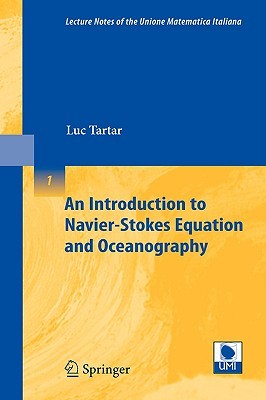
- We will send in 10–14 business days.
- Author: Luc Tartar
- Publisher: Springer
- Year: 2006
- Pages: 247
- ISBN-10: 3540357432
- ISBN-13: 9783540357438
- Format: 15.6 x 23.4 x 1.5 cm, minkšti viršeliai
- Language: English
- SAVE -10% with code: EXTRA
An Introduction to Navier-Stokes Equation and Oceanography (e-book) (used book) | bookbook.eu
Reviews
Description
In the spring of 1999, I taught (at CARNEGIEMELLON University) a graduate course entitled Partial Di?erential Equations Models in Oceanography, and I wrote lecture notes which I distributed to the students; these notes were then made available on the Internet, and they were distributed to the participants of a Summer School held in Lisbon, Portugal, in July 1999. After a few years, I feel it will be useful to make the text available to a larger audience by publishing a revised version. To an uninformed observer, it may seem that there is more interest in the Navier-Stokes equation nowadays, but many who claim to be interested show such a lack of knowledge about continuum mechanics that one may wonder about such a super?cial attraction. Could one of the Clay Millennium Prizes bethereasonbehindthisrenewedinterest?Readingthetextoftheconjectures to be solved for winning that particular prize leaves the impression that the subject was not chosen by people interested in continuum mechanics, as the selected questions have almost no physical content. Invariance by translation or scaling is mentioned, but why is invariance by rotations not pointed out 1 andwhyisGalileaninvariance omitted, asitistheessentialfactwhichmakes 1 Velocities involved for ordinary ?uids being much smaller than the velocity of light c, no relativistic corrections are necessary and Galilean invariance should then be used, but one should be aware that once the mathematical equation has been written it is not automatic that its solutions will only use velocities bounded by c.
EXTRA 10 % discount with code: EXTRA
The promotion ends in 23d.07:58:15
The discount code is valid when purchasing from 10 €. Discounts do not stack.
- Author: Luc Tartar
- Publisher: Springer
- Year: 2006
- Pages: 247
- ISBN-10: 3540357432
- ISBN-13: 9783540357438
- Format: 15.6 x 23.4 x 1.5 cm, minkšti viršeliai
- Language: English English
In the spring of 1999, I taught (at CARNEGIEMELLON University) a graduate course entitled Partial Di?erential Equations Models in Oceanography, and I wrote lecture notes which I distributed to the students; these notes were then made available on the Internet, and they were distributed to the participants of a Summer School held in Lisbon, Portugal, in July 1999. After a few years, I feel it will be useful to make the text available to a larger audience by publishing a revised version. To an uninformed observer, it may seem that there is more interest in the Navier-Stokes equation nowadays, but many who claim to be interested show such a lack of knowledge about continuum mechanics that one may wonder about such a super?cial attraction. Could one of the Clay Millennium Prizes bethereasonbehindthisrenewedinterest?Readingthetextoftheconjectures to be solved for winning that particular prize leaves the impression that the subject was not chosen by people interested in continuum mechanics, as the selected questions have almost no physical content. Invariance by translation or scaling is mentioned, but why is invariance by rotations not pointed out 1 andwhyisGalileaninvariance omitted, asitistheessentialfactwhichmakes 1 Velocities involved for ordinary ?uids being much smaller than the velocity of light c, no relativistic corrections are necessary and Galilean invariance should then be used, but one should be aware that once the mathematical equation has been written it is not automatic that its solutions will only use velocities bounded by c.


Reviews